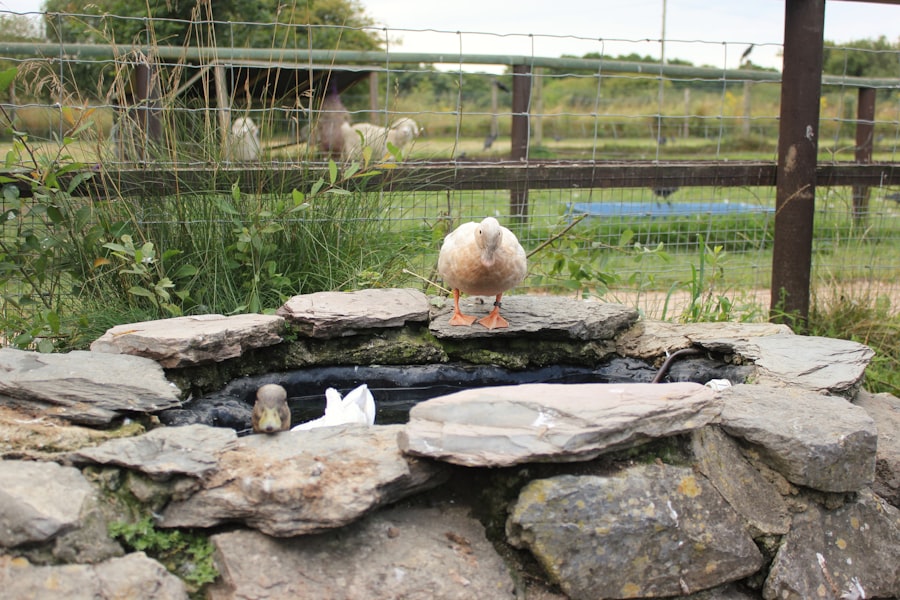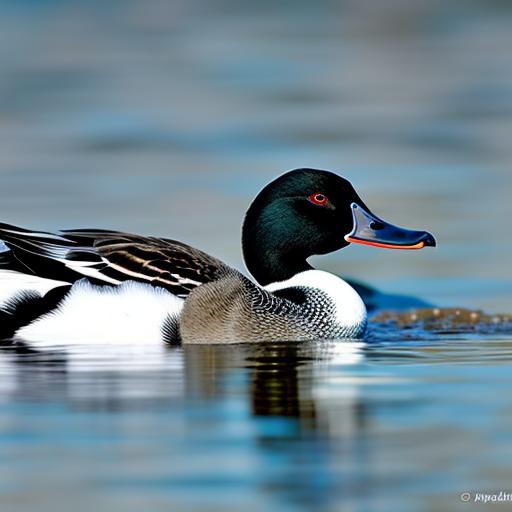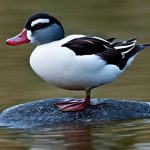Ducks are a diverse group of waterfowl that come in a variety of breeds and colors. Among these breeds, white and black ducks are particularly notable for their unique characteristics and importance in various industries. White duck breeds, such as the Pekin and Aylesbury, are known for their striking appearance and are often used for meat production. On the other hand, black duck breeds, like the Cayuga and Black Swedish, have a rich history and are valued for their egg-laying abilities. Understanding the characteristics and breeding habits of these white and black duck breeds is essential for those interested in raising ducks or appreciating their beauty.
Key Takeaways
- White and black duck breeds are distinct and have unique characteristics.
- White duck breeds are known for their egg-laying abilities and are bred for exhibition.
- Black duck breeds have their origins in Asia and are known for their meat production.
- The main differences between white and black duck breeds are their physical features and intended use.
- Popular white duck breeds for farming and exhibition include the Pekin and the Aylesbury.
White Duck Breeds: Characteristics and Breeding
White duck breeds are known for their pure white feathers, which make them stand out among other duck breeds. The Pekin duck is one of the most popular white duck breeds, known for its large size and plump body. It has a yellow bill and orange legs, which contrast beautifully with its white plumage. Another well-known white duck breed is the Aylesbury, which has a more elongated body shape and a pink bill.
When it comes to breeding white ducks, it is important to provide them with proper housing and nesting areas. They require access to clean water for swimming and bathing, as well as a balanced diet that includes grains, vegetables, and protein sources. White ducks are generally good layers, producing large eggs that are excellent for baking or eating. They can be bred naturally or through artificial insemination to ensure successful reproduction.
Black Duck Breeds: Origins and Physical Features
Black duck breeds have a rich history that dates back centuries. The Cayuga duck is one of the oldest black duck breeds in North America, believed to have originated from wild ducks found in the Cayuga Lake region of New York. It has glossy black feathers that shimmer with shades of green and purple in the sunlight. Another popular black duck breed is the Black Swedish, which has a more upright posture and a black bill.
Black duck breeds are known for their striking appearance and unique physical features. They have dark plumage that helps them blend into their surroundings, making them less visible to predators. Their feathers also have a natural oil coating that provides insulation and waterproofing. Black ducks have a calm and docile temperament, making them easy to handle and raise.
Differences Between White and Black Duck Breeds
While both white and black duck breeds are beautiful in their own right, there are several key differences between them. In terms of physical features, white ducks have pure white feathers, while black ducks have dark plumage that can range from glossy black to shades of green or purple. White ducks tend to have a plumper body shape, while black ducks often have a more streamlined appearance.
In terms of temperament and behavior, white ducks are generally more active and curious, while black ducks are known for their calm and docile nature. White ducks are also known for their loud quacking, which can be heard from a distance. In terms of egg and meat production, white ducks are often preferred for their larger eggs and meatier bodies. However, black ducks are valued for their excellent egg-laying abilities.
Popular White Duck Breeds for Farming and Exhibition
White duck breeds are highly sought after for both farming and exhibition purposes. The Pekin duck is one of the most popular white duck breeds for farming due to its large size and fast growth rate. It is known for its tender meat and is often used in the production of duck meat products. The Aylesbury duck is another popular white breed that is highly valued for its meat quality.
In terms of exhibition, the White Crested duck is a favorite among breeders and enthusiasts. It has a distinctive white crest on its head, which adds to its overall elegance and charm. The White Indian Runner duck is another popular exhibition breed known for its unique upright posture and slender body shape.
Black Duck Breeds for Meat and Egg Production

Black duck breeds are also highly valued for their meat and egg production capabilities. The Cayuga duck, with its dark plumage and flavorful meat, is often raised for meat production. It has a good feed-to-meat conversion ratio and produces tender and succulent meat. The Black Swedish duck is another black breed that is known for its excellent meat quality.
In terms of egg production, the Khaki Campbell duck is a popular black breed that is highly valued for its high egg-laying abilities. It can lay up to 300 eggs per year, making it a favorite among small-scale farmers and backyard enthusiasts. The Ancona duck is another black breed known for its good egg-laying capabilities.
White and Black Duck Breeds: Temperament and Behavior
Ducks are social animals that thrive in the company of others. They are generally friendly and curious, but their temperament can vary depending on the breed. White ducks, such as the Pekin and Aylesbury, are known for their active and curious nature. They enjoy exploring their surroundings and are often seen waddling around in search of food or water.
Black ducks, on the other hand, have a more calm and docile temperament. They are generally easy to handle and are less likely to become aggressive or territorial. This makes them ideal for families or individuals who want to raise ducks as pets or for exhibition purposes.
Health and Care of White and Black Duck Breeds
Like any other animal, ducks can be prone to certain health issues if not properly cared for. Common health issues in ducks include respiratory infections, parasites, and foot problems. It is important to provide ducks with a clean and dry living environment, as well as access to fresh water for swimming and bathing. Regular veterinary check-ups and vaccinations are also essential for maintaining their health.
In terms of care requirements, both white and black duck breeds require proper housing, feeding, and grooming. They need access to a secure and spacious enclosure that protects them from predators and provides them with enough space to move around. Ducks should be fed a balanced diet that includes grains, vegetables, and protein sources. Grooming involves regular cleaning of their feathers and trimming of their nails.
Challenges in Raising White and Black Duck Breeds
Raising ducks can come with its own set of challenges, regardless of the breed. One common challenge is providing ducks with a suitable living environment that meets their specific needs. Ducks require access to clean water for swimming and bathing, as well as a secure enclosure that protects them from predators.
Another challenge is ensuring proper nutrition for ducks. They require a balanced diet that includes grains, vegetables, and protein sources. It is important to provide them with the right amount of food and monitor their weight to prevent obesity or malnutrition.
Future of White and Black Duck Breeds: Conservation and Preservation Efforts
Conservation and preservation efforts are crucial for maintaining the genetic diversity of white and black duck breeds. Many duck breeds are at risk of extinction due to habitat loss, pollution, and crossbreeding with other breeds. It is important to support organizations and initiatives that work towards conserving and preserving these breeds.
Individuals can also contribute to conservation efforts by raising rare or endangered duck breeds themselves. By doing so, they can help maintain the genetic diversity of these breeds and ensure their survival for future generations. Additionally, educating others about the importance of preserving these breeds can help raise awareness and support for conservation efforts.
If you’re interested in learning more about breeding ducks, you might also want to check out this informative article on the Poultry Wizard website. It discusses the different breeds of ducks, including white and black duck breeds, and provides valuable insights into their characteristics and care. To further expand your knowledge, you can also explore related articles on topics such as quail egg incubation (link: https://poultrywizard.com/breeding-quail/do-quails-sit-on-their-eggs/), natural hatching of chicken eggs (link: https://poultrywizard.com/breeding-chickens/how-long-for-chicken-eggs-to-hatch-naturally/), and the importance of the floor in a chicken coop (link: https://poultrywizard.com/keeping-chickens/floor-of-chicken-coop/). Happy reading!
FAQs
What are white and black duck breeds?
White and black duck breeds are domesticated ducks that have either white or black feathers. These breeds are commonly raised for their meat, eggs, and feathers.
What are some examples of white duck breeds?
Some examples of white duck breeds include the Pekin duck, the Aylesbury duck, and the Muscovy duck. These breeds are known for their white feathers and are commonly raised for their meat.
What are some examples of black duck breeds?
Some examples of black duck breeds include the Cayuga duck, the Black Swedish duck, and the Ancona duck. These breeds are known for their black feathers and are commonly raised for their meat and eggs.
What is the difference between white and black duck breeds?
The main difference between white and black duck breeds is the color of their feathers. White duck breeds are typically larger and have a plumper appearance, while black duck breeds are smaller and more streamlined.
What is the lifespan of white and black duck breeds?
The lifespan of white and black duck breeds varies depending on the breed and the conditions in which they are raised. On average, domesticated ducks can live up to 10 years.
What is the diet of white and black duck breeds?
White and black duck breeds are omnivores and eat a variety of foods, including insects, plants, and small animals. They are commonly fed a diet of commercial duck feed, which provides them with the necessary nutrients for growth and development.
What are some common uses for white and black duck breeds?
White and black duck breeds are commonly raised for their meat, eggs, and feathers. Their meat is often used in dishes such as duck confit and Peking duck, while their feathers are used for down pillows and comforters.
Meet Walter, the feathered-friend fanatic of Florida! Nestled in the sunshine state, Walter struts through life with his feathered companions, clucking his way to happiness. With a coop that’s fancier than a five-star hotel, he’s the Don Juan of the chicken world. When he’s not teaching his hens to do the cha-cha, you’ll find him in a heated debate with his prized rooster, Sir Clucks-a-Lot. Walter’s poultry passion is no yolk; he’s the sunny-side-up guy you never knew you needed in your flock of friends!







